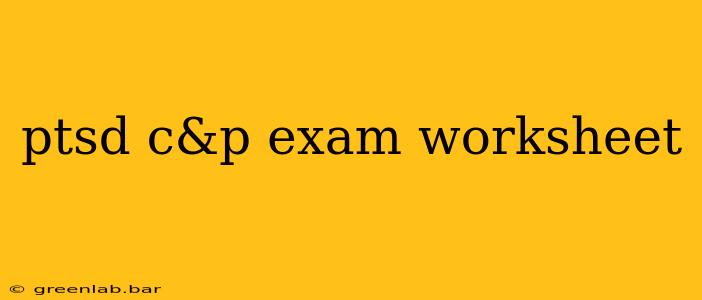The Department of Veterans Affairs (VA) Compensation and Pension (C&P) exam is a crucial step for veterans seeking benefits for Post-Traumatic Stress Disorder (PTSD). This worksheet is designed to help you prepare for your exam, ensuring you provide the most complete and accurate information possible to support your claim. Remember, this is a guide, not a substitute for professional legal advice. Consult with a Veterans Service Officer or attorney for personalized assistance.
Understanding the C&P Exam for PTSD
The C&P exam for PTSD is a thorough evaluation conducted by a qualified medical professional. The examiner will review your medical history, conduct a mental health assessment, and gather information about your symptoms and their impact on your daily life. The goal is to determine the severity of your PTSD and its connection to your military service.
Key Areas Covered in the Exam:
- Medical History: This includes details about your military service, any traumatic events experienced, and your subsequent mental health history. Be prepared to discuss specific incidents, dates, and locations.
- Symptom Assessment: The examiner will evaluate the presence and severity of PTSD symptoms, such as intrusive thoughts, nightmares, avoidance behaviors, negative alterations in mood and cognition, and alterations in arousal and reactivity. Be prepared to provide specific examples of how these symptoms manifest in your daily life.
- Functional Impact: The examiner will assess how your PTSD symptoms impact your daily functioning, including your ability to work, maintain relationships, and participate in social activities. Be prepared to provide concrete examples of how your PTSD affects your daily activities.
- Mental Status Examination: This involves a clinical assessment of your current mental state, including your mood, thought processes, and behavior.
Preparing for Your C&P Exam:
1. Gather Your Documentation:
- Military Records: Obtain copies of your military service records, including deployment information and any relevant medical records from your time in service.
- Medical Records: Collect all relevant medical records from civilian healthcare providers, therapists, and psychiatrists. This includes diagnoses, treatment plans, and progress notes.
- Personal Statements: Write down a detailed account of your experiences, symptoms, and how your PTSD affects your daily life. Be specific and provide concrete examples.
- Lay Statements: Ask family members, friends, or coworkers to write statements detailing how your PTSD impacts your relationships and daily activities. These statements can provide valuable corroborating evidence.
2. Review Common PTSD Symptoms:
Familiarize yourself with the diagnostic criteria for PTSD. Understanding the symptoms will help you accurately describe your experiences to the examiner. This includes:
- Intrusion: Recurrent, unwanted distressing memories; recurrent distressing dreams; dissociative reactions (flashbacks); intense or prolonged psychological distress at exposure to internal or external cues that symbolize or resemble an aspect of the traumatic event; marked physiological reactions to internal or external cues that symbolize or resemble an aspect of the traumatic event.
- Avoidance: Persistent avoidance of stimuli associated with the traumatic event; persistent avoidance of thoughts or feelings associated with the traumatic event.
- Negative Alterations in Cognition and Mood: Inability to remember an important aspect of the traumatic event; persistent and exaggerated negative beliefs or expectations about oneself, others, or the world; persistent distorted cognitions about the cause or consequences of the traumatic event that lead the individual to blame himself/herself or others; persistent negative emotional state (e.g., fear, horror, anger, guilt, or shame); markedly diminished interest or participation in significant activities; feelings of detachment or estrangement from others; persistent inability to experience positive emotions.
- Alterations in Arousal and Reactivity: Irritable behavior and angry outbursts (with little or no provocation) typically expressed as verbal or physical aggression toward people or objects; reckless or self-destructive behavior; hypervigilance; exaggerated startle response; problems with concentration; sleep disturbances.
3. Practice Answering Questions:
Practice articulating your experiences clearly and concisely. Anticipate questions the examiner might ask and prepare your answers. Focus on the impact of your PTSD on your daily life.
4. Be Honest and Thorough:
Provide accurate and complete information. Don't minimize your symptoms or omit relevant details. The more information you provide, the better the examiner can understand the severity of your condition.
After the C&P Exam:
After the exam, you will receive a copy of the examiner's report. Review it carefully and ensure it accurately reflects your experiences and symptoms. If there are any inaccuracies, you have the right to request corrections or clarifications.
This worksheet is intended as a guide to help you prepare for your C&P exam. Remember to seek professional advice from a Veterans Service Officer or attorney for personalized assistance in navigating the VA benefits process. Your health and well-being are paramount, and having the right support can significantly improve your chances of a successful outcome.

